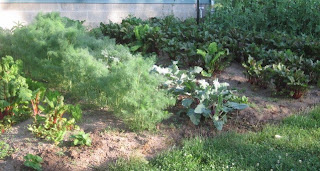

Pickled Beets are amazing. Last year I became obsessed with beets. It's sad that I let so much time go without beets in my life. I say that because my mom used to make beets but until last year I haven't had them since childhood. That is time wasted.
But, no worries. I am making up for lost time.
Pickled beets have the most amazing texture - smooth and firm. It's hard to believe they're not candy. We've already canned a big batch of beets this year and I made sure to include a lot of onions. The Hub and I were always fighting over the onions in the batch from last year so I had to make sure we had a bunch. Plopping a few hard boiled eggs into each jar won't hurt either - until you've eaten the 2 eggs and there's none left. ;)
If you forgot to grow beets this year, don't fret. Run over to your local farmer's market (or grocery store if you're really desperate) and buy some.
15-20 medium sized beets
1 pound of onions
3 1/2 cups of white vinegar
2 cups sugar
1 1/2 cups of beet water (cooking liquid)
1 tbsp kosher salt
a dozen hard boiled eggs
Prep your beets. Cut the stems off about 1 inch from the top. Trim the root off. The reason why you want to cut the stem an inch from the top is to ensure the glorious beet color doesn't leach out during cooking. Place the beets in a large pot and cover with water. Bring to a simmer and simmer for about an hour.
Once tender when pricked with a fork remove from heat by using a slotted spoon to pull the beets out of the hot water. Save 1 1/2 cups of the beet cooking liquid Let cool until they are cool enough that you can handle them. Now cut off the top and peel the skin. Slice the beets into about 1/4 inch thick slices.

Slice the onions.
Prepare your lids and jars (about 6). Do this by running them through a scalding hot water bath.
Bring a large canning pot filled with water to a boil.
In a separate pot bring the beet cooking liquid, vinegar, sugar, and salt to a boil.
Carefully pack the jars by layering the onions and beets. Be careful not to touch the edge of the jar. Fill to about 3/4 inch from the top. This can be accomplished most easily with a canning funnel.
Pour the liquid over the tops, covering the beets completely until the liquid comes to about 1/2 inch from the top. Cover with the sealing lid and screw on the top. Carefully lift the jars with canning tongs into the boiling water and boil for about 5 minutes. Remove and let sit on a towel covered area on your counter. Allow to sit until the seal is made. You can tell the jar has a seal when the center of the lid is impressed and not 'clickable'.
Serve as a wonderful snack, breakfast treat or as part of your antipasta tray during your next football party.

































